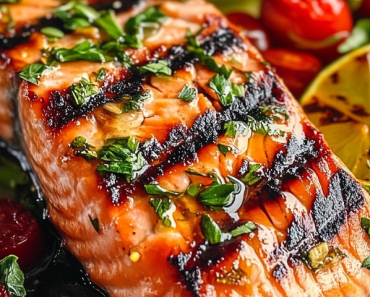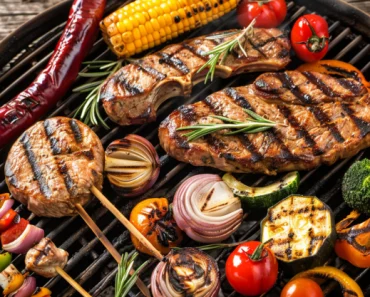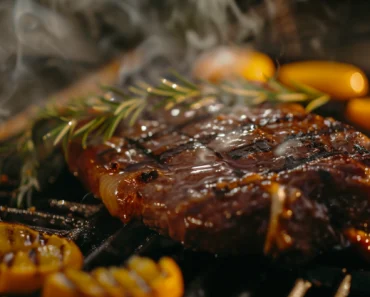ADVERTISEMENT
Introduction
Grilling is not just a cooking method; it’s a tradition, a celebration, and an art form that brings people together. From backyard barbecues to sophisticated culinary endeavors, grilling offers endless possibilities. This article will delve into the best grilling recipes of all time, providing a detailed guide for anyone looking to master the grill.
1. Types of Grilling
Grilling is a versatile cooking method that can be adapted in various ways to suit different foods, preferences, and techniques. Understanding the types of grilling can help you choose the best method for your needs and enhance your overall grilling experience. Here’s an overview of the main types of grilling:
1. Direct Heat Grilling
- Description: Involves cooking food directly over the heat source.
- Best For: Thin cuts of meat, burgers, hot dogs, seafood, and vegetables.
- Benefits: Quick cooking time, produces a nice sear and grill marks, locks in juices.
- Limitations: Can lead to flare-ups, requires constant attention to avoid burning.
2. Indirect Heat Grilling
- Description: Food is placed in an area of the grill without direct heat underneath. The grill lid is closed to allow heat to circulate around the food, similar to an oven.
- Best For: Larger cuts of meat, whole chickens, roasts, ribs, and tougher cuts that need longer cooking times.
- Benefits: Even cooking, prevents burning, suitable for slow cooking and smoking.
- Limitations: Longer cooking time, requires more space on the grill.
3. Charcoal Grilling
- Description: Uses charcoal briquettes or lump charcoal to generate heat.
- Best For: Adding a smoky flavor to meats, vegetables, and fruits.
- Benefits: Produces a rich, smoky flavor, higher heat for searing.
- Limitations: Takes longer to heat up, harder to control temperature, requires cleanup of ash.
4. Gas Grilling
- Description: Utilizes propane or natural gas as the heat source.
- Best For: Convenience and quick grilling of a wide variety of foods.
- Benefits: Easy temperature control, quick startup, cleaner burning.
- Limitations: Less smoky flavor compared to charcoal, requires propane or natural gas supply.
5. Electric Grilling
- Description: Ideal for indoor use or where open flames are prohibited, uses electricity to generate heat.
- Best For: Apartment living, indoor cooking, small spaces.
- Benefits: Safe for indoor use, easy to clean, quick to heat up.
- Limitations: Lacks the smoky flavor of charcoal and gas, depends on electricity supply.
6. Infrared Grilling
- Description: Uses infrared technology as the heat source instead of an open flame.
- Best For: Quick searing of meats and high-heat cooking.
- Benefits: Even heat distribution, high temperatures for quick searing, efficient energy use.
- Limitations: Can be expensive, requires learning curve for temperature control.
7. Smoking
- Description: Involves cooking food at low temperatures in a controlled smoke environment for extended periods.
- Best For: Tough cuts of meat like brisket, pork shoulder, ribs, and whole poultry.
- Benefits: Deep, smoky flavor, tenderizes tough cuts, ideal for large portions.
- Limitations: Time-consuming, requires patience and skill to maintain temperature and smoke levels.
8. Rotisserie Grilling
- Description: Food, especially whole birds or large cuts of meat, is cooked on a rotating spit.
- Best For: Whole chickens, turkeys, roasts.
- Benefits: Even cooking, retains moisture, self-basting.
- Limitations: Requires a rotisserie attachment, longer cooking time.
Each type of grilling offers unique benefits and is suited to specific culinary tasks. Whether you’re searing a steak with direct heat, slow-cooking ribs with indirect heat, or adding smoky flavor with charcoal or smoking, the diverse world of grilling ensures there’s a method to meet every griller’s needs.
2. Grilling Techniques
Mastering various grilling techniques can enhance your cooking skills and ensure you achieve the best results with different types of food. Here are some essential grilling techniques to consider:
1. Searing
- Description: Quickly cooking the surface of the food at high temperatures to create a caramelized crust.
- Best For: Steaks, chops, burgers, and seafood.
- Technique: Preheat the grill to high heat, oil the grates, and place the food directly over the heat source. Sear each side for 1-3 minutes to develop a crust before moving to indirect heat to finish cooking if needed.
2. Rotisserie
- Description: Cooking food on a rotating spit over direct or indirect heat.
- Best For: Whole chickens, turkeys, roasts, and large cuts of meat.
- Technique: Secure the food on the rotisserie spit, ensuring it is balanced. Set the grill to indirect heat, and cook slowly, allowing the food to rotate and baste in its juices for even cooking.
3. Smoking
- Description: Cooking food at low temperatures with smoke over a long period.
- Best For: Brisket, ribs, pork shoulder, and other tough cuts of meat.
- Technique: Use a smoker or set up a grill for indirect heat with a water pan. Add wood chips or chunks for smoke, and maintain a low, steady temperature, typically between 225°F and 275°F (107°C and 135°C).
4. Planking
- Description: Cooking food on a soaked wooden plank, which adds a subtle smoky flavor.
- Best For: Fish (especially salmon), chicken, and vegetables.
- Technique: Soak the plank in water for at least an hour. Preheat the grill to medium heat, place the food on the plank, and set the plank on the grill. Close the lid and cook until done, allowing the food to absorb the flavors from the wood.
5. Foil Packet Grilling
- Description: Wrapping food in aluminum foil to steam and cook evenly.
- Best For: Vegetables, fish, and delicate foods.
- Technique: Place the food and seasonings in the center of a large piece of aluminum foil. Fold and seal the foil to create a packet. Place the packet on the grill over medium heat, turning occasionally to ensure even cooking.
6. Reverse Searing
- Description: Slowly cooking meat at a low temperature before searing it at high heat.
- Best For: Thick steaks, roasts, and large cuts of meat.
- Technique: Preheat the grill to low heat. Cook the meat over indirect heat until it reaches an internal temperature about 10-15°F below the desired final temperature. Move the meat to direct high heat and sear each side for a few minutes to develop a crust.
7. Caveman Style
- Description: Cooking food directly on hot coals without a grill grate.
- Best For: Thick steaks, vegetables like peppers and eggplants.
- Technique: Prepare a bed of hot coals. Place the food directly on the coals, turning occasionally until the outer layer is charred and the inside is cooked to your liking. Brush off any ash before serving.
8. Beer Can Chicken
- Description: Cooking a whole chicken upright with a can of beer inserted into the cavity for moisture and flavor.
- Best For: Whole chicken.
- Technique: Open a can of beer and place it in the cavity of the seasoned chicken. Stand the chicken upright on the grill over indirect heat. Cook until the chicken reaches an internal temperature of 165°F (74°C), allowing the beer to steam and keep the meat moist.
Each grilling technique offers unique advantages and flavors, allowing you to experiment and find the best methods for your favorite foods. By mastering these techniques, you can elevate your grilling game and impress your guests with perfectly cooked meals.
3. Best Grilling Recipes
Grilling is a beloved cooking method that brings out the best in a variety of foods. Here are some of the best grilling recipes that have stood the test of time, perfect for any occasion and sure to impress your family and friends.
1. Perfectly Grilled Steak
- Ingredients: Ribeye or sirloin steak, olive oil, salt, pepper, garlic, fresh rosemary.
- Instructions:
- Preheat grill to high heat.
- Brush steaks with olive oil and season generously with salt, pepper, and minced garlic.
- Grill steaks for 4-5 minutes per side for medium-rare, adding a sprig of rosemary to the grill for extra flavor.
- Let rest for 5 minutes before serving.
2. Classic BBQ Chicken
- Ingredients: Chicken breasts, thighs, or drumsticks, BBQ sauce, salt, pepper, garlic powder, onion powder.
- Instructions:
- Preheat grill to medium heat.
- Season chicken with salt, pepper, garlic powder, and onion powder.
- Grill chicken, turning occasionally and basting with BBQ sauce, until internal temperature reaches 165°F (74°C).
- Serve with extra BBQ sauce on the side.
3. Grilled Vegetable Medley
- Ingredients: Bell peppers, zucchini, asparagus, red onions, olive oil, balsamic vinegar, salt, pepper.
- Instructions:
- Preheat grill to medium-high heat.
- Cut vegetables into manageable pieces and toss with olive oil, balsamic vinegar, salt, and pepper.
- Grill vegetables until tender and slightly charred, about 5-7 minutes per side.
- Serve as a side dish or over a bed of rice or quinoa.
4. Garlic Butter Shrimp Skewers
- Ingredients: Large shrimp (peeled and deveined), melted butter, garlic, lemon juice, salt, pepper, parsley.
- Instructions:
- Preheat grill to medium heat.
- Thread shrimp onto skewers.
- Mix melted butter with minced garlic, lemon juice, salt, and pepper.
- Brush shrimp with garlic butter mixture.
- Grill shrimp for 2-3 minutes per side until opaque.
- Garnish with fresh parsley and serve with lemon wedges.
5. Grilled Pineapple Slices
- Ingredients: Fresh pineapple, brown sugar, cinnamon, honey.
- Instructions:
- Preheat grill to medium heat.
- Slice pineapple into rings.
- Mix brown sugar and cinnamon, and sprinkle over pineapple slices.
- Grill pineapple for 3-4 minutes per side until caramelized.
- Drizzle with honey before serving.
6. Smoky Grilled Salmon
- Ingredients: Salmon fillets, olive oil, lemon juice, dill, salt, pepper.
- Instructions:
- Preheat grill to medium heat.
- Brush salmon fillets with olive oil and season with lemon juice, dill, salt, and pepper.
- Grill salmon skin-side down for 6-8 minutes, then flip and cook for another 2-4 minutes until the fish flakes easily with a fork.
7. Grilled Corn on the Cob
- Ingredients: Fresh corn on the cob, butter, salt, pepper, fresh herbs (optional).
- Instructions:
- Preheat grill to medium heat.
- Peel back corn husks without removing them, remove the silk, and re-cover the corn with husks.
- Soak the corn in water for 15-20 minutes.
- Grill corn, turning occasionally, for 15-20 minutes until tender.
- Peel back husks and brush with butter, salt, pepper, and fresh herbs if desired.
8. Juicy Grilled Burgers
- Ingredients: Ground beef (80/20 blend), salt, pepper, cheese slices, burger buns, lettuce, tomato, onion, pickles.
- Instructions:
- Preheat grill to medium-high heat.
- Form ground beef into patties and season with salt and pepper.
- Grill burgers for 3-4 minutes per side for medium doneness.
- Add cheese slices during the last minute of cooking.
- Serve on toasted buns with your favorite toppings.
These recipes highlight the versatility and delicious potential of grilling. Whether you’re in the mood for a hearty steak, tender chicken, fresh vegetables, or sweet grilled fruits, these recipes are sure to make your grilling sessions enjoyable and flavorful.
4. Health Aspects of Grilling
Grilling is not only a popular and flavorful cooking method but also offers several health benefits when done correctly. Here’s a look at the health aspects of grilling, including its advantages and some precautions to keep in mind:
Health Benefits of Grilling
- Reduced Fat Content
- Natural Fat Reduction: Grilling allows fats to drip off the meat, resulting in lower overall fat content. This can be beneficial for those looking to reduce their fat intake without sacrificing flavor.
- Less Need for Added Fats: Unlike frying or sautéing, grilling often requires little to no added fats, helping to keep calorie intake in check.
- Nutrient Preservation
- Retention of Vitamins and Minerals: Grilling can help preserve essential nutrients, especially in vegetables, which might be lost in boiling or frying. Quick cooking times and high heat help retain water-soluble vitamins like vitamin C and B vitamins.
- Caramelization: Grilling caramelizes the natural sugars in fruits and vegetables, enhancing their flavor without adding extra calories or unhealthy additives.
- Enhanced Flavor Without Unhealthy Additives
- Natural Flavor Enhancement: The high heat of the grill enhances the natural flavors of food, reducing the need for high-calorie sauces, dressings, and seasonings.
- Smoky Flavor: Grilling imparts a unique smoky flavor that can make healthy foods like lean meats and vegetables more appealing.
- Promotes Healthy Eating
- More Vegetables and Fruits: Grilling makes vegetables and fruits more enjoyable to eat, encouraging higher consumption of these nutrient-rich foods.
- Healthy Protein Choices: Grilling is well-suited for lean cuts of meat, poultry, and fish, which are healthier protein options compared to processed or fatty meats.
Precautions and Considerations
- Formation of Harmful Compounds
- Polycyclic Aromatic Hydrocarbons (PAHs): These are formed when fat drips onto the heat source, causing flames and smoke. The smoke contains PAHs that can adhere to the surface of the food. To minimize this, trim excess fat from meats and avoid direct contact with flames.
- Heterocyclic Amines (HCAs): HCAs are created when meats are cooked at high temperatures. To reduce HCA formation, avoid charring meat and use marinades, which can significantly reduce HCAs.
- Avoiding Cross-Contamination
- Separate Raw and Cooked Foods: Always use separate plates and utensils for raw and cooked foods to prevent cross-contamination and reduce the risk of foodborne illnesses.
- Proper Cooking Temperatures: Ensure meats are cooked to safe internal temperatures to kill harmful bacteria. Use a meat thermometer to verify doneness (e.g., 165°F for poultry, 145°F for fish, and 160°F for ground meats).
- Moderation and Balance
- Balanced Diet: While grilled foods are healthy, it’s important to maintain a balanced diet that includes a variety of cooking methods and food types.
- Portion Control: Pay attention to portion sizes, especially with high-calorie marinades or sauces.
Tips for Healthier Grilling
- Use Lean Cuts of Meat: Choose leaner cuts of beef, pork, and poultry to reduce saturated fat intake.
- Incorporate Vegetables and Fruits: Make grilled vegetables and fruits a central part of your meal.
- Marinate Wisely: Use marinades that contain herbs, spices, and acidic ingredients like lemon juice or vinegar, which can reduce the formation of harmful compounds and add flavor without extra fat.
- Control Cooking Temperature: Avoid cooking at excessively high temperatures and opt for medium heat to reduce the risk of charring and burning.
Grilling, when done correctly, can be a healthy and delicious way to prepare meals. By following these guidelines and being mindful of potential risks, you can enjoy the many health benefits of grilling while minimizing any negative effects.
Conclusion
In conclusion, grilling is a versatile and enjoyable cooking method that enhances the natural flavors of a wide variety of foods. From succulent steaks and juicy chicken to vibrant vegetables and sweet fruits, there are countless foods that can be grilled to perfection. Understanding different types of grilling and mastering essential techniques can elevate your culinary skills, making each grilling session a flavorful success.
The health aspects of grilling further add to its appeal. With proper techniques, grilling can reduce fat content, preserve essential nutrients, and encourage the consumption of healthy foods without the need for excessive additives. However, it’s important to be aware of and mitigate potential risks, such as the formation of harmful compounds and the need for food safety practices.
Exploring the Best Grilling Recipes of All Time can inspire and guide you to create exceptional meals that showcase the versatility and deliciousness of grilled foods. Whether you’re hosting a summer barbecue, preparing a family dinner, or simply enjoying the process of cooking outdoors, the Best Grilling Recipes of All Time offer a wealth of ideas to keep your menu exciting and varied.
By integrating the Best Grilling Recipes of All Time into your cooking repertoire, you can impress your guests and satisfy your family with delectable grilled dishes. These recipes highlight the best techniques and flavors that make grilling such a beloved cooking method. Grilling remains a cherished tradition that brings people together, combining the pleasures of good food and good company in every meal.
ADVERTISEMENT






